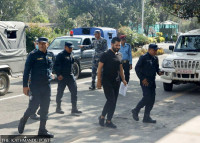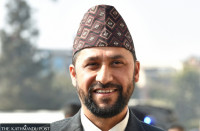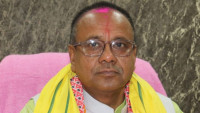National
As officials prepare for the census this year, they are hopeful it will be more reliable
Inadequate training and school teachers as enumerators were issues in the past. This time, the Central Bureau of Statistics has called applications for 52,000 workers.
Srizu Bajracharya
When a team from the National Census 2011 Citizen Observation Committee visited Kaski and Mustang to monitor the ongoing census in 2011, local leaders were certain that the information of the census would not be accurate.
“The Central Bureau of Statistics had sent teachers as supervisors and enumerators, but in our observation we found that they were not well trained for the job,” said Yogendra B Gurung, professor at the Central Department of Population Studies of Tribhuvan University. “Many had not even been trained on data collection and were found asking others to collect the data. We also found that the Education Ministry had not granted leave to the teachers deployed for the census work.”
When the 2011 census report was published, many upbraided the bureau saying the data was not genuine. Many cast doubts over the census data for underrepresenting people from different categories like religious minorities, caste groups. Some even claimed that the census data were forged.
As the Central Bureau of Statistics prepares for the census later this year with the hiring process of enumerators and supervisors underway, the stakes are high.
“We have always understood that the data collection process is the most important phase, where supervisors and enumerators’ role is vital to the outcome of the data,” said Nebin Lal Shrestha, the director-general at the Central Bureau of Statistics.
During the 2011 census, enumerators were mostly teachers as it was believed that local teachers will understand the significance of the population count, and their status and relationship with people in communities would ease the census participation, according to Shrestha.
However, in hindsight, the bureau’s management found that employing teachers was problematic because of their dual role of teaching and overseeing the data collection process.
“We realised that their full participation would be challenging, therefore this time, for the Census 2021, we have addressed this issue more holistically,” said Gyanendra Bajracharya, a director at the bureau who previously steered the census data collection operation. “We have suggested that we need more local residents to lead the data collection process in their areas and communities.”
Nepal has been conducting a population census every 10 years since 1961 and the next to be conducted this year will be the 12th.
According to the bureau, it also plans to recruit more local youths with grade 12 education as enumerators and have teachers in the role of supervisors or trainers to review the data collection process.
It has called for applications to recruit a workforce of about 52,000 people–39,000 enumerators, 8,000 supervisors, and about 5,000 officials–for the census.
According to earlier census reports of 1991 and 2001, enumerators were mainly primary school teachers and fresh recruits, while the supervisors were mostly high school teachers and university students of population and statistics. In 1991 and 1981, the bureau had appointed school teachers and people with at least an SLC degree or at least eight years of schooling as enumerators.
“It’s a huge survey that requires the workforce to be trained in depth as we have to operate within a time frame and that too uniformly. This is why our training is very essential to carry out the census,” said Shrestha.
The bureau plans to open seven provincial census offices in mid-March and offices in the districts as well as 349 local units in mid-April.
The census will be conducted in May and June.
Population censuses are conducted with the primary objective of finding out the total enumeration of the population of a country to provide essential information on their spatial distribution, age and sex structure, and other key social and economic characteristics.
Census data, around the world, is regarded as the most significant count of a country’s people and is related to basic population characteristics.
In Nepal, it also determines political representation, budget planning and investment besides providing data for development plans and strategies.
Further, in Nepal, because the government does not undertake other periodic surveys as in other countries, the census tries to cover a lot of information such as land ownership, according to Shrestha.
The recent US census, for example, had 12 questions.
Nepal’s 2021 census has some 80 questions including those like the purpose of a house built other than residential purpose and if a house was rebuilt through the government’s earthquake reconstruction fund. Six new questions have been added for this census.
Given the large number of questions, insufficient training and other factors like limited time and supervisors and enumerators' careless interaction with the census participants, reliability of census data is often questioned.
“For example, when asking about religion, enumerators assume the participant’s religion. The same goes for addressing questions of gender, caste and language,” said a demographic expert who did not want to be named. “The enumerators’ interaction is highly influenced by their own set ideologies which can mislead the census’s purpose and data.”
This is precisely what the bureau’s training hopes to avoid, said Rishi Ram Sigdel, director of the training section of the Central Bureau of Statistics.
“During our training, we advocate that supervisors and the enumerators address every question with clarity and we discourage them from prompting or influencing people’s answers,” he said.
The bureau plans three phases of training: the master trainer programme to train trainers, training for supervisors and training for enumerators with multiple supervision.
Training will also pay attention to the data collectors’ interpretation of the questions so that when explaining the questions to participants they don’t modify or distort the meaning of the questions, said Sigdel.
“Before the real census, we will also conduct a mock test of the supervisors and the enumerators. We will be asking them to take interviews with their fellow colleagues' families or their neighbours to check if they are ready to work in the field,” said Sigdel.
The importance of training cannot be overemphasised, according to the expert.
“It is necessary that the census operation pay more attention to training and assessing the training outcome,” he said.
In Nepal, census data are collected twice: first through supervisors and then through the enumerators. While the supervisors address a brief questionnaire with 10 questions related to housing, agriculture, technical education and access to financial services, enumerators ask 70 questions related to demographic characteristics.
The census this year also has a third questionnaire at the community level with about 15 questions to be asked at the ward offices of each local unit in the country in an effort to strengthen federalism.
“For local governments this data will be vital to their future functioning and planning since the country now exercises a federal system,” said Gurung the professor. “For profiling and planning developments the data will be essential and so they too will be concerned of accuracy and are likely to be more involved in the process.”
But officials at the Central Bureau of Statistics maintain that an accurate census is not only its responsibility but also that of the people.
“People don’t understand the value of their participation; they don’t understand that as much as enumerators and supervisors are accountable for data, so is their participation,” said Shrestha, the director general.
In attempts to make the census as accurate as possible, the collected information will also be verified with ward offices and each data collector will be provided with an enumeration map to ensure they leave no one behind.
Further, the bureau will have a quick response team that addresses calls from a toll-free number to get the counts they have missed. During the three-month long post enumeration period, it will manage the census's omissions.
“We are well aware of where things can go wrong and where we need to be careful and so we are working very carefully to address all the issues that we have heard from people,” added Shrestha.
Professor Gurung of the Central Department of Population Studies of Tribhuvan University feels optimistic, given the preparations.
“On the overall, I am hopeful about this census as the bureau really has addressed most of the issues of the past,” he said.
But despite their efforts officials are well aware that changing people’s negative perception of the census data will be difficult as this idea of false data is tied too closely to people’s sentiments and ideology.
“For example, many Newa people in the Valley believe their population count should be more than the data provided by the census data as Kathmandu Valley is home to the Newa people. But if the fertility rate is not double the rate earlier, then the population is likely not to see any significant increase,” explained Bajracharya. “Unless each family produces two children, the demography will not change. The population of a group is tied to fertility and mortality rate. But people easily forget that because of their opinion and misconceptions.”
But given the large amount of data involved in the census process, Shrestha admits that there could be mistakes.
“We have always tried to address the issues that have been highlighted to us,” he said. “It’s for the people to trust this process and be more aware of why their participation is significant. They must understand that this undertaking is for them.”
And to highlight the importance of the participation of the people, the slogan for the Census 2021 is ‘‘My Census, My Participation’.




 10.12°C Kathmandu
10.12°C Kathmandu















